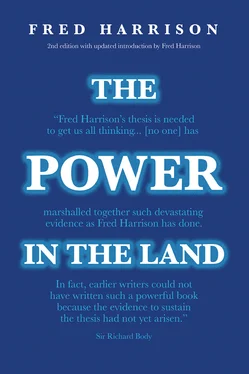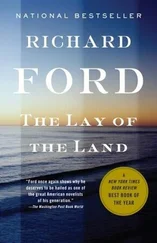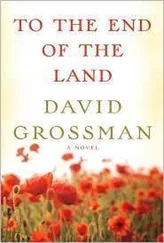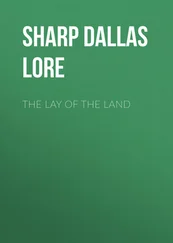Botha distinguishes three broad categories of time: secular, long and short-term. In the first case, a second or third-generation land monopolist who sells at a hundred times the original purchase price cannot be said to have speculated; the land was not bought with an intention to capitalise on increasing land values within the lifetime of the buyer. An example of this is the Spanish olive grower who owned five acres near Madrid. He and his family fled from General Franco’s army in 1940. The family split itself between London and New York. The parents died, and after the death of Franco the children decided to investigate their ancestral past. They discovered that the five acres that they had inherited were worth £5m. in 1980, just 40 years after the last olive had been picked. 14 During that time, the land had remained idle, but the suburbs of Madrid grew outwards and around the site. So far as the land users of the Spanish capital were concerned, the owner of the five acres was doing a Rip Van Winkle act: he had gone to sleep. Still, the value of the land soared with the prosperity of the community. The children, however, while benefiting from their unearned millions, were not speculative owners in the sense which we wish to emphasise for the purposes of this study. 15
At the other end of the time-scale, people who buy and quickly re-sell land for a profit usually do so for less spectacular gains. This sharp wheeling-dealing characterises the tail-end of a cycle in land values, when speculative ‘fever’ has gripped a wider circle of people who, perceiving the huge gains made by those who bought for rock-bottom prices, decide to gate-crash the market.
The more interesting time-period, for Botha, is the intermediate phase, his ‘relatively short period’ which, in terms of his three categories, is the long period. He cites the example of someone holding land for 10 years, having bought it at agricultural use values and allowing it to lie fallow in the knowledge that urban expansion will force up the price in the fullness of time.
This intermediate time-scale is characterised by a conscious decision to methodically identify and acquire tracts which will eventually be required for development; and the willingness to wait while values rise to obtain a profit well over what can be obtained in the course of normal trading in a competitive market. Botha’s example of 10 years was intended to be illustrative. It does not fit well into an 18-year pattern. Intuitively, we would expect speculators who were tutored in the art of dealing in land to buy when prices were at their lowest — at the beginning of a cycle — and sell just before prices reached their peaks: they would sell to the ‘mugs’ in time to get out of the market before the inevitable crash.
The risky phase of the speculative boom is the last 12 to 18 months. During this period, dealers tend to be the innocents who have entered the market at a very late stage. Most of the profits have been taken by the shrewd dealers, who have held the land for most of the cycle and then withdrawn while the going was good. The latest entrants are those who buy at the speculatively- high prices which bear no relation to the performance of the economy; and they have a rapidly-decreasing margin of time in which to raise their prices, find new buyers and complete the transactions before the alarm bells begin to ring. Thus, we would postulate that a 15 to 16-year period would be the optimum period. This would ensure maximum profits and guarantee a safe withdrawal from the market before the slump. If this time-scale is popularly employed by land speculators, we will have recognised an important element of the dynamics of the 18-year cycle in land values.
The empirical evidence verifies our hypothesis. In the most exhaustive study ever conducted into motives behind the ownership of land on the urban fringe — nearly 700 owners of undeveloped land at the edge of six metropolitan areas in North America were interviewed between 1977 and 1979 16 — it was discovered that the transition in ownership from traditional rural owners to investors and developers‘begins more than 15 years before the land is actually developed for urban use’. 17 Similar time-scales were revealed in a study of 56 vacant sites in South Wales; 64% of the sites were held idle for 15 years or over, and the most popular duration of vacancy was the 15-19 years period (27%). 18 The evidence supports the view that speculators are willing to hold land vacant for a considerable period of time in the expectation of making substantial unearned profits from the needs of society. Providing the purchases are made at the right time, and in the right place, speculation in land Conforms to what Fortune , the American business magazine, deemed ‘a law that seems to make certain you will win’. 19 Thus, there appears to be a significant synchronisation between the time horizons of speculators, and the 18-year cycle.
Other features of speculation and land monopoly can be highlighted by contrasting land with capital as factors of production. In the past, the differences have been disguised. G. D. H. Cole, a leading left-wing historian of working-class institutions, exemplifies the perverse insistence on anaesthetising people from an appreciation of the internal dynamics of the Western economic system:
... in highly industrialized countries in particular the distinction between land and capital has lost most of its economic importance, at any rate where a class of great landowners, clearly distinct from other capitalists, has ceased to exist. 20
Rental income, likewise, is conflated into the catch-all category of property income. 21 By blurring the differences, the deleterious influence of the land speculator is ascribed to the owner of capital. Yet land and capital are different species of phenomena.
For a start, the power acquired by those who buy land depends crucially on the unique characteristics of land. The time-horizons are different in the land and capital markets. Land can be held idle for long periods because it is not perishable. The pressure on landowners in a contest of economic strength is far weaker than that which confronts labour and capital. Agricultural land will renew itself, and therefore retain its value; owners need not, therefore, capitalise their assets for long periods. Land which derives its value from locational advantages presents no problems whatever. But capital in the form of machines and buildings perishes and must therefore pay for itself within a limited period, during which the capitalist cannot avoid the costs of maintenance. There is no escape from this by transforming capital into cash, for unless it is employed — by being lent to others — it either depreciates in value as a result of inflation, or does not earn an income (in which case it might as well be used for consumption).
Furthermore, there is a distinct difference in the ability to finance loans originally taken out to buy land or accumulate stocks. Except during deep recessions, banks will continue to lend money when the asset is land, even (or rather, especially) during uncertain times. This makes it possible to refinance loans used to buy land: thus, the speculator can hold out for better prices which must eventually come his way. Credit to help to finance inventories, however, is much more difficult to obtain. Credit shortages occur far more regularly as a deterrent to stock accumulation. Indeed, the acute credit shortage associated with the downturn of the shorter, five-year cycles is a direct limitation on accumulation. 22
The next major class of differences between land and capital relates to the impact on the workings of the economy. Land hoarding results in a contraction in the supply of what is a fixed factor: there is no way of making more land, and reclamation is of no significance. So the price of land is forced up. Firms which are restricted in their choice of locations—because of the need for access to special services, or raw materials, or markets, for example—have two options. They must either increase their product prices, which is not usually possible in a competitive market, or they must absorb the higher cost of rent out of profits. As a result, consumer satisfaction and the output of goods are reduced. Hoarding manufactured goods, however, does not destabilise aggregate demand, 23 and if abnormal profits are made out of a rise in prices, other manufacturers will be attracted into the market. This forces down prices and removes the incentive to hoard goods in warehouses. Manufacturers, then, have every incentive to meet demand at the lowest Competitive prices, which raises consumer satisfaction and ensures the full employment of resources.
Читать дальше












